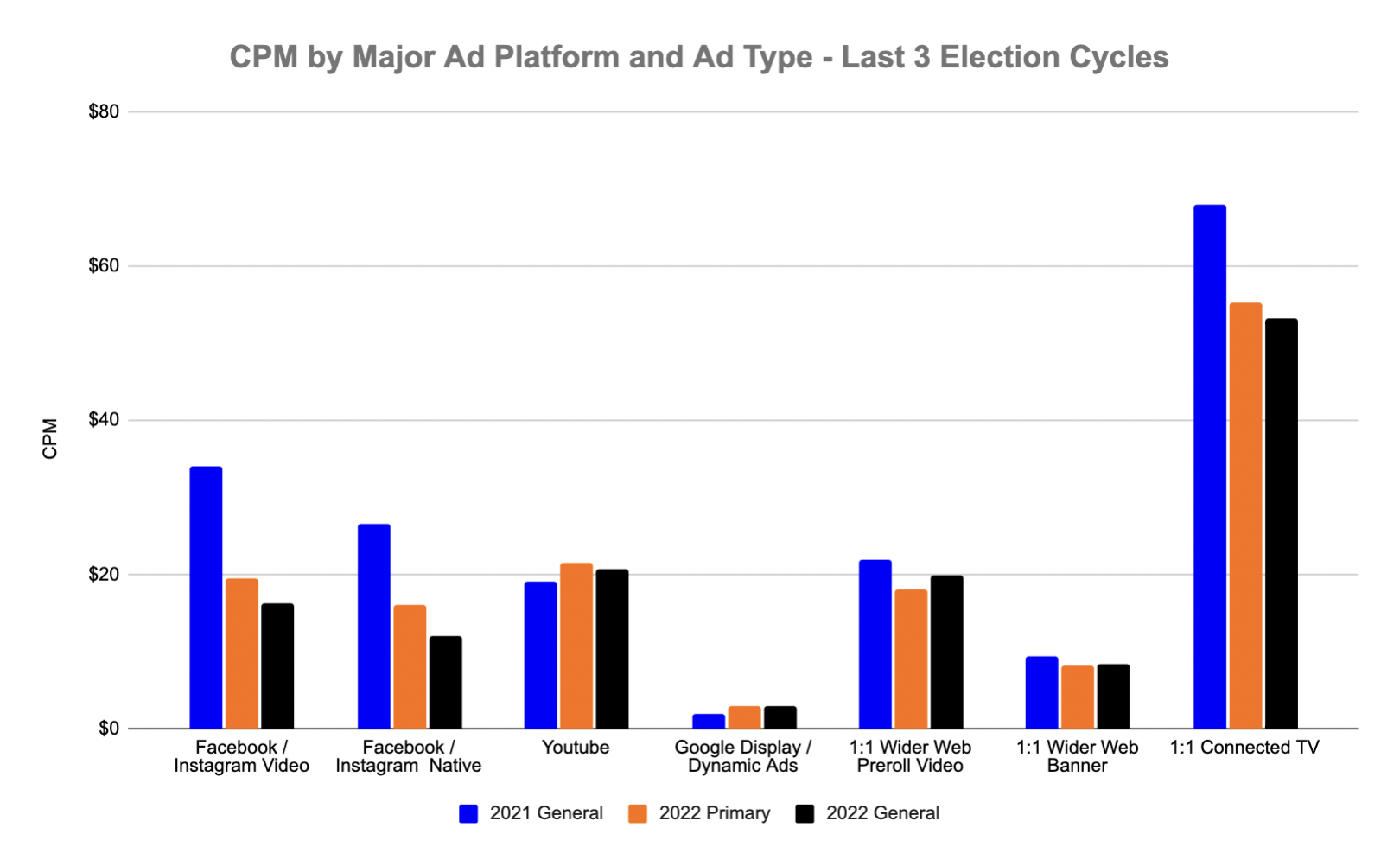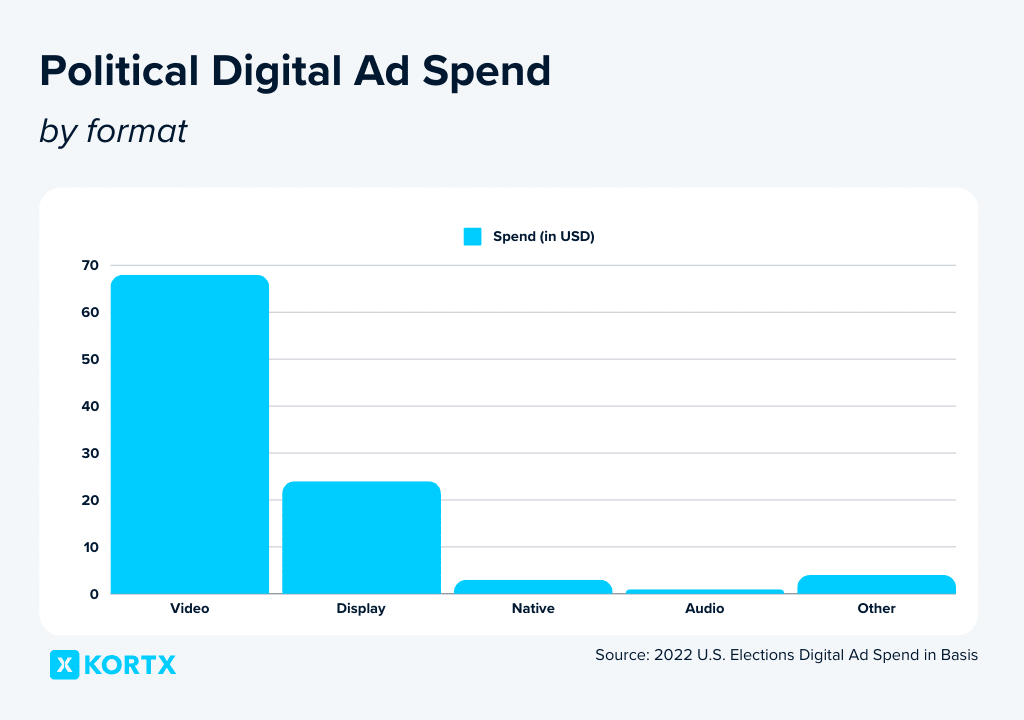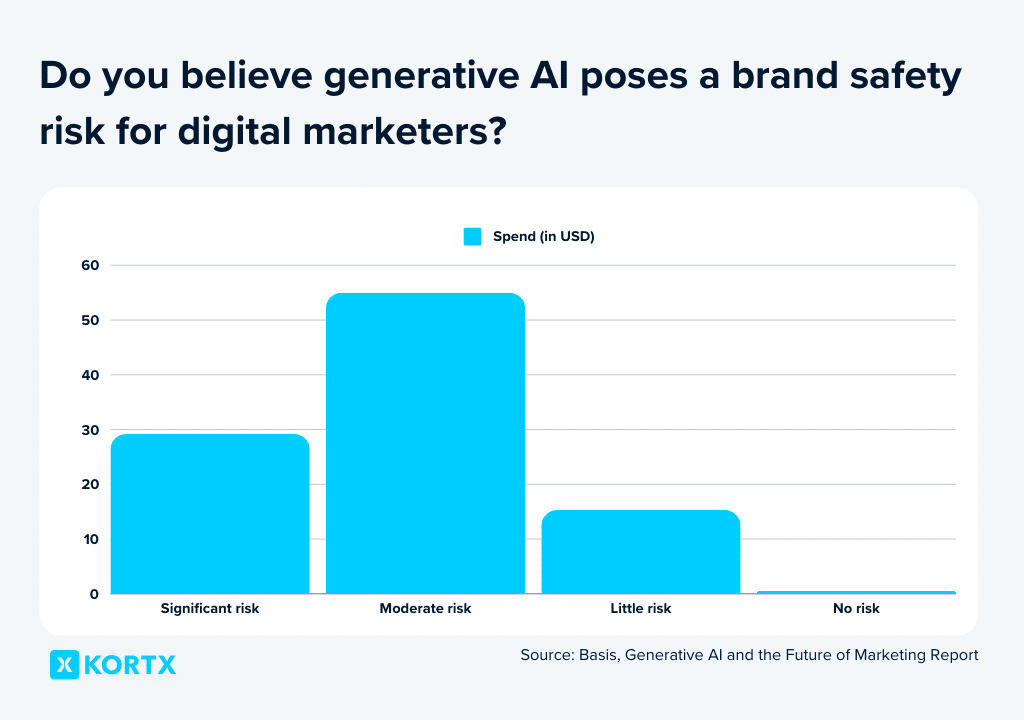Advertising and media buyers need to prepare for a tricky 2024 election cycle.
The divisive presidential race, heated Senate seat battles, and controversial ballot measures are already dispatching political ad spending, and it is only set to grow.
Ad space competition will continue to intensify for the last half of 2024 as political campaigns ramp up. Prices will be pushed higher, and brands will likely see increased competition, especially in key geographic locations.
Opting out of election season advertising is not an option for most. Agencies and brands must find creative ways to make their media budgets work. Understanding how your media plan will be impacted and securing media buys will protect your brand’s visibility and reputation during election season.
📚 Related article: 5 Key Political Advertising Trends in 2024
Explore the 5 key political ad trends shaping the 2024 election season.
1. Media buying prices will increase with more competition from political ad placements.
Political ad spending during the 2024 election cycle is expected to hit $15 billion, up 13% from the last presidential election. While inventory may be tight, the steep price increases are expected to be the most significant challenge for advertisers.
CPMs rise towards Election Day.
Election spending drives up CPMs, especially on certain programmatic platforms, with a steady early pattern and a surge near Election Day.
In 2022, CPMs saw a 40% increase between January and November, particularly in the final eight days of campaigning.

While video CPMs stayed relatively stable, the high spending on this format from August to November drove overall CPMs up. Display ads saw significant inflation close to the 2020 election, and native ad formats had the steepest increase, with CPMs spiking over 140% in November compared to January.
Competition for inventory & location will be intense.
Political candidates are willing to pay top dollar to secure ad placements, leaving other advertisers with fewer options and potentially higher costs.
Another Inventory Dilemma: The FCC’s Equal Time Rule requires broadcasters to offer opposing candidates equal air time. This can limit available ad slots and lead to potential crowding out of non-political advertisers, especially during the lead-up to Election Day.
Swing states like Nevada, Arizona, Michigan, Wisconsin, Georgia, Pennsylvania, and North Carolina will face the highest spending, with their key counties—often seen as “election bellwethers”—experiencing the most intense competition, further driving up prices.
How can brands make the most of their ad dollars during a politically charged election season?
“To get the best results as the election nears, it’s crucial to choose your platforms wisely and keep your budget flexible. Different platforms have varying policies on political ads, so aligning with those that match your brand’s safety needs is essential. Be mindful of where your audience spends their time and consider shifting your budget to platforms that offer a more brand-safe environment, especially if they avoid political content.
As media costs rise and inventory tightens, staying agile with your budget allows you to seize opportunities and reallocate funds to channels that deliver the strongest ROI. In this high-stakes environment, a strategic, adaptable approach is key to maintaining visibility and protecting your brand’s reputation.”
The final countdown: Q4 will see the most intense competition for ad space.
The final quarter of 2024, especially the last 30 days before Election Day, will see the most intense competition and skyrocketing prices. CTV, a popular spot for political ads, will see considerable disruption.
50% of candidates’ digital ad budgets were spent in the last 30 days before Election Day, mainly for persuasion and early voting. Another 25% of political budgets were spent in the final 10 days for ‘get out the vote’ campaigns.
This last-minute push, common in political campaigns, drives up costs in the broader ad market as competition for premium CTV and digital video placements intensifies.
💡 What should my brand do?
Secure your ad inventory early, and prepare for a cost surge in the last 30 days before the election.
Research the specific states, counties, and cities where you plan to advertise during election season. Understanding the nuances of local races and ballot issues will help you anticipate how political ads might affect your most important media markets at a geographical level. To manage expenses, consider shifting your budget to less competitive markets.
📚 Related article: 7 Inspiring Political Marketing Examples for 2024
Explore the top 7 political marketing examples to inspire your 2024 campaign.
2. Channel considerations: political advertisers love video & CTV.
Video and CTV are key for political advertisers due to their reach, targeting, and cost-effectiveness. The rising demand for video ad space will impact video-centric channels CTV, linear TV, online display, and social media platforms like YouTube and Instagram.

Video remains the dominant focus of political digital ad spending.
45% of all digital political ad dollars are estimated to flow to CTV, a 26% increase from the 2020 cycle. This increased demand may push other advertisers out of prime ad slots, especially in competitive markets.

💡 What should my brand do?
Carefully vet CTV platforms to confirm your brand appears in suitable environments. If the CTV landscape becomes overly competitive or expensive, you may need to shift your budget to other channels, like Display or Digital Out-of-Home.
Although there’s no foolproof solution, partnering with the right experts can give brands and agencies the visibility and guidance they need to navigate these challenges effectively.
Is media buying feeling overwhelming?
Partner with our experts to secure prime ad slots and optimize your political advertising strategy.
3. Prioritizing brand safety among misinformation in the age of AI-generated content.
Election season presents significant brand safety risks, including the potential for ads to appear alongside negative political content or misinformation.
All political ads, regardless of tone, may create a “horn effect.”
Political ads often have a negative tone, stirring strong emotions that can tarnish nearby brands, a phenomenon called the “horn (or hangover) effect.”
Political advertising may make brand advertising less effective.
According to a survey conducted by SONAR™, when a political advertisement immediately preceded a brand advertisement:
- The brand’s ad was considered 32% less relevant and 14% less likable.
- The brand’s reputation was rated 35% lower.
- Consumers perceived the product quality to fall by 24%.
SONAR™ also found that even positive-toned political ads generated negative emotions in consumers.
Generative AI & social media layoffs pose new misinformation challenges.
Misinformation, a significant concern during the 2020 election, is getting worse. Experts believe the rise of genAI, or generative AI, will exacerbate this issue. GenAI can help bad actors mislead voters via deepfake images, videos, and audio. This fake or altered digital media also creates significant brand safety issues for brands.
Even before the election season, nearly 100% of advertisers agree that genAI poses a brand safety risk for digital marketers.

Recent layoffs at major tech companies like Meta, X, and Amazon have reduced the workforce responsible for monitoring and removing harmful content. Social media is especially concerning as it’s where misinformation spreads the most.
While platforms promise new tools to protect against misinformation, advertisers should be cautious—social channels could pose unique brand safety risks this election season.
💡 What should my brand do?
Partner with agencies like KORTX to guarantee ads appear in premium, non-divisive environments.
Use allow lists and block lists to avoid political and low-quality sites. Smart contextual targeting can help ads show up in the right places, and programmatic guaranteed deals or private marketplaces (PMPs) can secure premium spots.
For a positive impact, focus on lighter, more upbeat, and humor-driven creative to stand out against the heavy political content.
How can brands maintain control over ad placement during election season?
“Exclusion and inclusion lists can control where their ads appear within the programmatic ecosystem, whether at the URL level (e.g., avoiding sites like Foxnews.com) or vertical level (e.g., excluding all news content). The focus is placing ads in environments that align with the brand’s values.”
Strategic Planning for Success in a High-Stakes Election Year
Advertisers must address these challenges directly so their messages resonate positively with consumers. In a year of record political ad spend, sticking to the usual playbook risks wasted budgets, lost customers, and brand damage. Campaigns must strategically plan around the impact of political ads, especially as Q4 kicks off.
Protect Your Brand During Election Season 2024
Learn about KORTX’s election season strategies that avoid political content, optimize ad placements, and maximize budget efficiency.
About the Author
Erik Stubenvoll is a Managing Director at KORTX with over 20 years of experience. When he is not learning about his client’s goals, he is on the sidelines with his wife at his daughter’s softball and soccer games or on the golf course.

